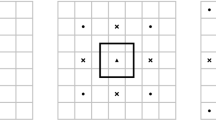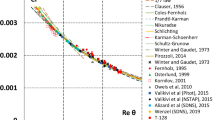Abstract
Direct Numerical Simulations (DNS) of Kolmogorov flows are performed at three different Reynolds numbers Re λ between 110 and 190 by imposing a mean velocity profile in y-direction of the form U(y) = F sin(y) in a periodic box of volume (2π)3. After a few integral times the turbulent flow turns out to be statistically steady. Profiles of mean quantities are then obtained by averaging over planes at constant y. Based on these profiles two different model equations for the mean dissipation ε in the context of two-equation RANS (Reynolds Averaged Navier–Stokes) modelling of turbulence are compared to each other. The high Reynolds number version of the k-ε-model (Jones and Launder, Int J Heat Mass Transfer 15:301–314, 1972), to be called the standard model and a new model by Menter et al. (2006), to be called the Menter–Egorov model, are tested against the DNS results. Both models are solved numerically and it is found that the standard model does not provide a steady solution for the present case, while the Menter–Egorov model does. In addition a fairly good quantitative agreement of the model solution and the DNS data is found for the averaged profiles of the kinetic energy k and the dissipation ε. Furthermore, an analysis based on flow-inherent geometries, called dissipation elements (Wang and Peters, J Fluid Mech 608:113–138, 2008), is used to examine the Menter–Egorov ε model equation. An expression for the evolution of ε is derived by taking appropriate moments of the equation for the evolution of the probability density function (pdf) of the length of dissipation elements. A term-by-term comparison with the model equation allows a prediction of the constants, which with increasing Reynolds number approach the empirical values.
Similar content being viewed by others
References
Jones, W.P., Launder, B.E.: The prediction of laminarization with a two-equation model of turbulence. Int. J. Heat Mass Transfer 15, 301–314 (1972)
Menter, F.R., Egorov, Y., Rusch, D.: Steady and unsteady flow modelling using the k-\(\sqrt{k}\,l\)-model. In: Hanjalic, K., Nagano, Y., Jakirlic, S. (eds.) Turbulence, Heat and Mass Transfer 5, Begell House (2006)
Wang, L., Peters, N.: Length scale distribution functions and conditional means for various fields in turbulence. J. Fluid Mech. 608, 113–138 (2008)
Wilcox, D.C.: Turbulence Modeling for CFD, 2nd edn. DCW Industries (1998)
Pope, S.B.: Turbulent Flows. Cambridge University Press, Cambridge, UK (2000)
Pope, S.B.: An explanation of the turbulent round-jet/plane-jet anomaly. AIAA J. 16, 279–281 (1978)
Hanjalic, K., Launder, B.E.: Sensitizing the dissipation equation to irrotational strains. J. Fluids Eng. Trans. ASME 102, 34–40 (1980)
Bardina, J., Ferziger, J., Reynolds, W.C.: Improved Turbulence Models Based on Large-eddy Simulation of Homogeneous, Incompressible, Turbulent Flows. Mechanical Engineering Department TF-19, Stanford University (1983)
Launder, B.E.: Phenomenological modelling: present... and future? In: Lumley, J.L. (ed.) Whither Turbulence? Turbulence at the Crossroads, pp. 439–485. Springer-Verlag, Berlin (1990)
Hanjalic, K.: Advanced turbulence closure models: a view of current status and future prospects. J. Heat Fluid Flow 15, 178–203 (1994)
Spalart, P.R.: Stratiegies for turbulence modelling and simulation. Int. J. Heat Fluid Flow 21, 252–263 (2000)
Meshalkin, L.D., Sinai, Y.G.: Investigation of the stability of a stationary solution of a system of equations for the place movement of an incompressible viscous liqquid. J. Appl. Math. 25, 1140–1143 (1961)
Borue, V., Orszag, S.: Numerical study of three-dimensional kolmogorov flow at high reynolds numbers. J. Fluid Mech. 306, 293–323 (1996)
Rotta, J.C.: Turbulente Stroemungen. Teubner Verlag, Stuttgart (1972)
Menter, F.R., Egorov, Y.: Revisiting the turbulent scale equation. In: Proc. IUTAM Symp., One Hundred Years of Boundary Layer Research (2006)
Menter, F.R., Egorov, Y.: Turbulence models based on the length scale equation. In: Fourth International Symposium on Turbulent Shear Flows Phenomena, Paper TSFP4-268 (2005)
Launder, B.E., Sharma, B.I.: Application of the energy-dissipation model of turbulence to the calculation of flow near a spinning disc. Lett. Heat Mass Transf. 1, 131–138 (1974)
Pekurovsky, D.: Parallel Three-dimensional Fast Fourier Transforms (p3dfft, v. 2.3). San Diego Supercomputer Center (2008)
Ruetsch, G.R., Maxey, M.R.: Small-scale features of vorticity and passive scalar fields in homogeneous isotropic turbulence. Phys. Fluids A3, 1587–1597 (1991)
Schiesser, W.E.: The Numerical Method of Lines: Integration of Partial Differential Equations. Academic Press, San Diego (1991)
Wang, L., Peters, N.: The length scale distribution function of the distance between extremal points in passive scalar turbulence. J. Fluid Mech. 554, 457–475 (2006)
Peters, N., Wang, L.: Dissipation element analysis of scalar fields in turbulence. C. R. Mechanique 334, 493–506 (2006)
Author information
Authors and Affiliations
Corresponding author
Additional information
Philip Schaefer and Markus Gampert are joint first authors.
Rights and permissions
About this article
Cite this article
Schaefer, P., Gampert, M., Goebbert, J.H. et al. Testing of Model Equations for the Mean Dissipation using Kolmogorov Flows. Flow Turbulence Combust 85, 225–243 (2010). https://doi.org/10.1007/s10494-010-9273-4
Received:
Accepted:
Published:
Issue Date:
DOI: https://doi.org/10.1007/s10494-010-9273-4




